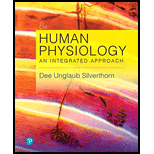
Concept explainers
a.
To determine: The diagram that shows an infant with patent ductus arteriosus.
Introduction: A ductus arteriosus is a condition in developing fetus in which a blood vessel connects the main pulmonary artery to the descending aorta. It is the channel through which the majority of the blood goes into the aorta.
b.
To determine: The reason why the majority of blood bypasses the lungs of the fetus.
Introduction: The blood in the pulmonary artery of the developing fetus bypasses the lungs and enters inside the aorta with the help of ductus arteriosus.
c.
To determine: The circuit having the higher resistance if the systemic side is greater than the pulmonary side of the circulatory system.
Introduction: The fetal bypass channel closes during the first day after the childbirth but remains open in majority of the cases.
d.
To determine: The side of the heart that is required to generate a higher pressure for overcoming resistance if the flow in systemic and pulmonary circulations is equal.
Introduction: The ductus arteriosus usually closes during the first day after, but in some cases, surgery is required for closing this patent ductus arteriosus.
e.
To determine: The direction of flow of blood through patent ductus arteriosus.
Introduction: About 4,000 babies in the United States maintain an open ductus arteriosus. This patent ductus arteriosus require surgery in such patients.
Want to see the full answer?
Check out a sample textbook solution
Chapter 15 Solutions
EBK HUMAN PHYSIOLOGY
- What is behavioral adaptarrow_forward22. Which of the following mutant proteins is expected to have a dominant negative effect when over- expressed in normal cells? a. mutant PI3-kinase that lacks the SH2 domain but retains the kinase function b. mutant Grb2 protein that cannot bind to RTK c. mutant RTK that lacks the extracellular domain d. mutant PDK that has the PH domain but lost the kinase function e. all of the abovearrow_forwardWhat is the label ?arrow_forward
- Can you described the image? Can you explain the question as well their answer and how to get to an answer to an problem like this?arrow_forwardglg 112 mid unit assignment Identifying melting processesarrow_forwardGive only the mode of inheritance consistent with all three pedigrees and only two reasons that support this, nothing more, (it shouldn't take too long)arrow_forward
- Oarrow_forwardDescribe the principle of homeostasis.arrow_forwardExplain how the hormones of the glands listed below travel around the body to target organs and tissues : Pituitary gland Hypothalamus Thyroid Parathyroid Adrenal Pineal Pancreas(islets of langerhans) Gonads (testes and ovaries) Placentaarrow_forward
 Human Physiology: From Cells to Systems (MindTap ...BiologyISBN:9781285866932Author:Lauralee SherwoodPublisher:Cengage Learning
Human Physiology: From Cells to Systems (MindTap ...BiologyISBN:9781285866932Author:Lauralee SherwoodPublisher:Cengage Learning Anatomy & PhysiologyBiologyISBN:9781938168130Author:Kelly A. Young, James A. Wise, Peter DeSaix, Dean H. Kruse, Brandon Poe, Eddie Johnson, Jody E. Johnson, Oksana Korol, J. Gordon Betts, Mark WomblePublisher:OpenStax College
Anatomy & PhysiologyBiologyISBN:9781938168130Author:Kelly A. Young, James A. Wise, Peter DeSaix, Dean H. Kruse, Brandon Poe, Eddie Johnson, Jody E. Johnson, Oksana Korol, J. Gordon Betts, Mark WomblePublisher:OpenStax College Principles Of Radiographic Imaging: An Art And A ...Health & NutritionISBN:9781337711067Author:Richard R. Carlton, Arlene M. Adler, Vesna BalacPublisher:Cengage Learning
Principles Of Radiographic Imaging: An Art And A ...Health & NutritionISBN:9781337711067Author:Richard R. Carlton, Arlene M. Adler, Vesna BalacPublisher:Cengage Learning





